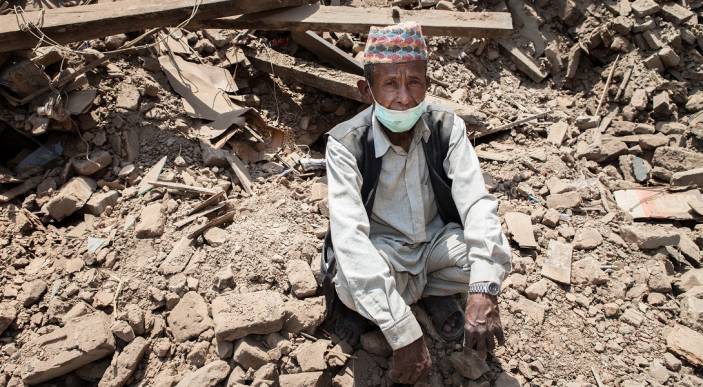Throughout the different humanitarian crises across the world, one problem persists – the needs of vulnerable groups continue to go uncovered (in conflicts and disasters). The needs of the most marginalised people – children, youth, older people, people with disabilities, ethnic groups – are not being adequately met by the responses.
 Their precise numbers are not well known, their input into solutions is not sought, programmes for their benefit are not well funded, and the nuances of how best to meet their needs not well understood by most major humanitarian agencies and their staff, despite the best of intentions.
Their precise numbers are not well known, their input into solutions is not sought, programmes for their benefit are not well funded, and the nuances of how best to meet their needs not well understood by most major humanitarian agencies and their staff, despite the best of intentions.
Next Monday the World Humanitarian Summit will take place in Istanbul. The Summit has been convened by UN Secretary General Ban Ki Moon, and organised by the UN Office for the Coordination of Humanitarian Affairs (OCHA). It is the first UN conference of its kind and it will bring together the humanitarian community with Heads of State, Government officials and representatives of civil society, the private sector, crisis-affected communities and multilateral organisations.
Bold steps must be taken
The World Humanitarian Summit has bold objectives. To put people at the centre of decision making and alleviate the suffering of the 100 million people at risk of being left behind. In order to achieve these objectives, bold steps must be taken by all those involved in responses including National Governments, NGOs and civil society, UN agencies and Red Cross/Red Crescent Societies. The extensive WHS regional and global consultations which have taken place over the last 18 months in the run up to the conference have vocalised a strong demand for a better response for the most marginalised and vulnerable.
To encourage a holistic response across the sector, HelpAge International and Plan International have collaborated with a group of leading NGOs (including World Vision, Islamic Relief and CAFOD) to identify the key actions that are required to equip humanitarian actors to respond to all vulnerable groups – be they children, older people, young people, women, or people with disabilities.
The Inclusion Charter: Five steps to imparial humanitarian response
The result of this collaboration is the Inclusion Charter, which identifies five steps to impartial humanitarian response for the most vulnerable. The Inclusion Charter attempts to set out the more integrated approach needed to succeed in humanitarian responses. The Inclusion Charter calls for the recognition of the needs of different groups and the progression towards fully inclusive humanitarian response through five key steps:
- Participation: engaging with all affected people, including the most marginalised, to ensure that their views are reflected in all aspects of the response.
- Data: collecting fully disaggregated data for different groups of people in order to understand the scale of different needs.
- Funding: working with donors to ensure that the needs of different groups are recognised and funding is allocated accordingly.
- Capacity: developing the knowledge and skills of humanitarian actors to help them identify the needs of marginalised groups and deliver an appropriate response.
- Coordination: working to ensure that coordination between humanitarian organisations guarantees the needs of all affected people are met.
The necessity for the Inclusion Charter is clear. In a report by Handicap International and HelpAge International on the Syrian Crisis it identified 30% of refugees in Jordan and Lebanon have specific needs of which one in five is affected by physical, sensory or intellectual impairment. Refugees affected by impairment, injury or chronic disease are twice as likely as the general refugee population to report signs of psychological distress.
In a financial study conducted by HelpAge International that looked at more than 16,000 proposed humanitarian projects between 2010 and 2014, the findings were even starker: less than one per cent had any activity specifically targeting older people. To put this into perspective, for the Nepal Earthquake 16% of those affected were older people and in the Japanese Tsunami it was 56%. For the current conflict in Ukraine, 67% of those affected are older people.
Leave No One Behind
The Leave No One Behind agenda has helped put the spotlight on the marginalised groups that the Inclusion Charter targets. One reason for the popularity of the Sustainable Development Goals was because their drafters overtly grasped the wide appetite for a broader concept of inclusion than the traditional “Vulnerable Group” approach. This broader understanding of and approach to inclusion is very well highlighted by the ODI video that David Cameron used at the launch of the Sustainable Development Goals emphasising the needs of all marginalised groups, including girls, people with disabilities and older people.
The World Humanitarian Summit is hugely welcome. It has to be engaged with and embraced. It has core themes and objectives that cannot be disputed – people centric, end and prevent conflict, safeguard humanity. But it must begin the change process that is needed within the sector to ensure humanitarian action evolves.
We need to emerge from our silos, gain confidence that taking a broader approach to inclusion will not undermine agency focus, or brand. The two days in Istanbul next week will not deliver the end result but will hopefully provide the impetus that key stakeholders within the sector require to initiate further change. Part of this change has to be the commitments and actions included within the Inclusion Charter if we really want to Leave No One Behind…
